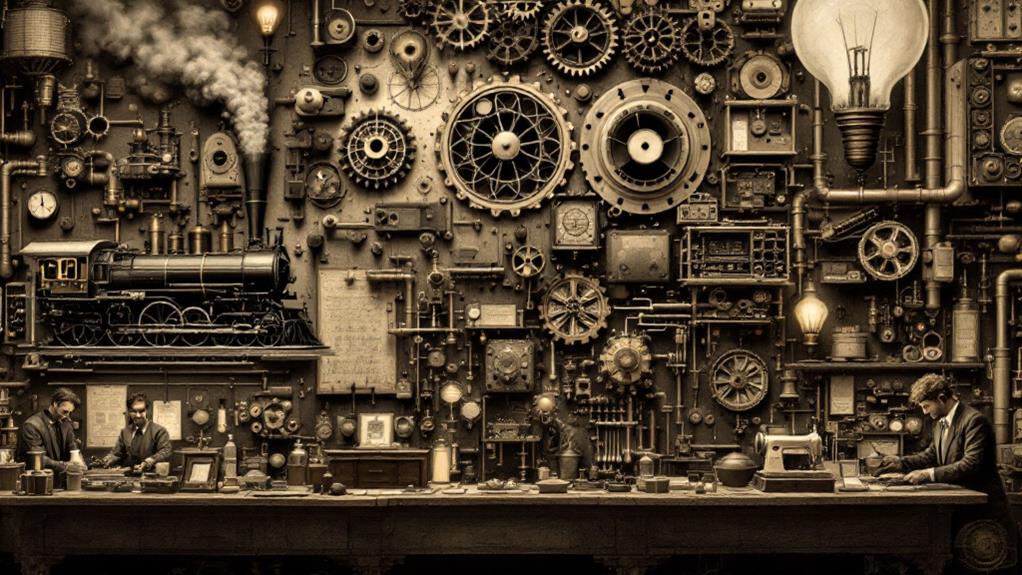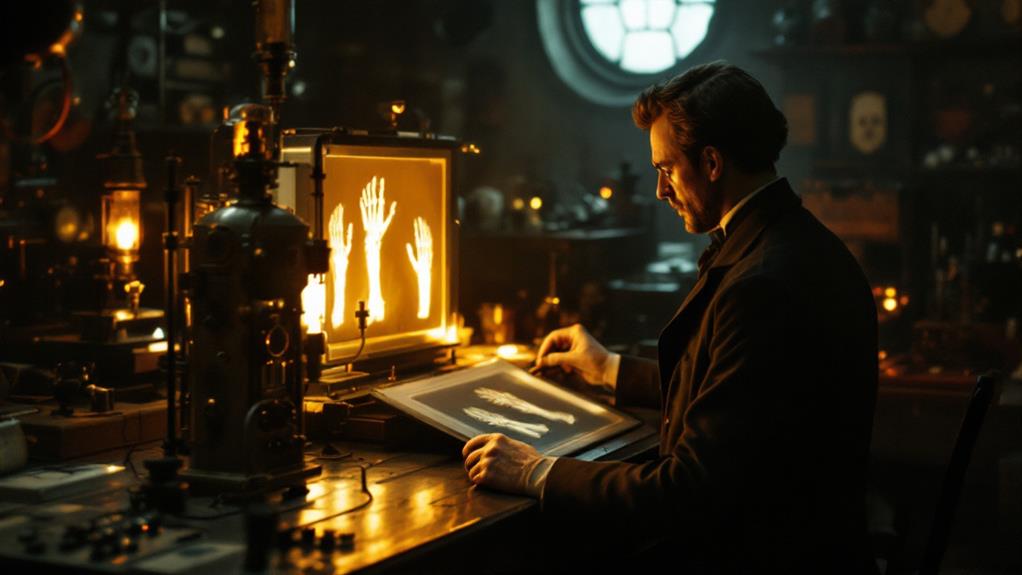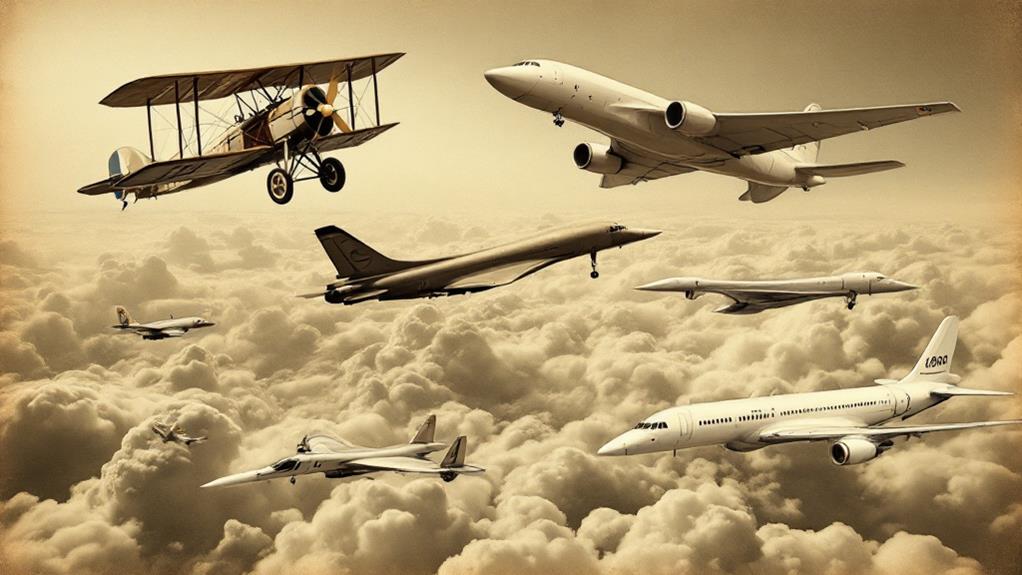Top Technology Breakthroughs in the 1800s: Innovations That Shaped the Modern World

The 1800s saw incredible technological advancements that still influence your daily life. The steam engine revolutionized transportation and industry, while the telegraph reshaped long-distance communication. Photography changed how you perceive the world, and the telephone transformed personal connections. The electric light bulb illuminated homes and cities, extending productivity. The sewing machine revolutionized clothing production, and the phonograph brought recorded music to the masses. These inventions laid the foundation for modern society, sparking further innovations and shaping the world you know today. Explore further to uncover how these 19th-century breakthroughs continue to impact your life in surprising ways.
The Steam Engine
The steam engine burst onto the scene in the 1800s, revolutionizing transportation and industry. You'd find these powerful machines in factories, mines, and ships, altering the way goods were produced and transported. The invention of the steam locomotive in 1804 by Richard Trevithick marked a turning point in railway history.
As locomotive technology advanced, you'd see trains crisscrossing countries, connecting cities and rural areas like never before. The steam engine's impact on maritime transport was equally far-reaching, with steamships replacing sailing vessels for both passenger and cargo transportation.
In factories, steam engines drove machinery, increasing production rates and enabling mass manufacturing. This led to the rise of industrial cities and a shift in the workforce from agriculture to manufacturing.
Despite their initial inefficiency, engineers continually improved steam engines throughout the century. You'd notice considerable advancements in energy efficiency, with later models using less fuel and producing more power. These improvements made steam power more accessible and cost-effective, further accelerating industrial growth and shaping the modern world we live in today.
Telegraph
With the advent of the telegraph in the 1830s, you'd witness a revolution in long-distance communication. Samuel Morse's invention allowed for rapid information transmission across vast distances, shrinking the world in ways previously unimaginable. You'd see messages that once took weeks to deliver now arriving in minutes, fundamentally changing how businesses operated and news spread.
The telegraph's impact on society was deep-rooted. You'd notice how it remodeled journalism, enabling reporters to relay breaking news almost instantly. Military strategies evolved as commanders could now coordinate troops over great distances. The financial world saw dramatic changes too, with stock prices and market information flowing rapidly between cities.
As you'd observe the telegraph's widespread adoption, you'd recognize it as the precursor to modern wireless communication. Its binary code system laid the groundwork for future technologies like the telephone and internet. The telegraph's ability to transmit information quickly and efficiently across continents marked a significant leap forward in human connectivity, setting the stage for the global communication networks we rely on today.
Photography

In the domain of visual documentation, photography emerged as an innovative technology in the 1800s. This remarkable invention revolutionized how people captured and preserved moments, forever changing the way we perceive and understand the world around us.
The Daguerreotype process, developed by Louis Daguerre in 1839, marked the birth of practical photography. This early photographic technique involved exposing a silver-plated copper sheet to iodine vapor, creating a light-sensitive surface. After exposure in a camera, the image was developed using mercury vapor and fixed with a salt solution.
As photography evolved, new methods like the calotype and wet plate collodion process emerged, improving image quality and reducing exposure times. These advancements made photography more accessible and versatile, allowing for portraits, environments, and even war documentation.
You can't overstate the impact of photography on society. It democratized visual representation, allowing people from all walks of life to have their likenesses captured. Furthermore, it became an essential tool for science, journalism, and art, shaping how we perceive and analyze the world around us.
Telephone
During the late 1800s, communication underwent a revolutionary change with the invention of the telephone. Alexander Graham Bell's pioneering invention in 1876 altered how people connected across distances. You could now hear someone's voice in real-time, even if they were miles away.
The telephone's impact was immediate and far-reaching. It accelerated business transactions, enabled faster emergency responses, and brought families closer together. Bell's patent for the "electrical speech machine" sparked a technological race, leading to rapid improvements in telephone technology.
As the century progressed, telephone networks expanded across cities and countries. You'd find telephone exchanges popping up, connecting more households and businesses. The technology evolved quickly, with early experiments in wireless communication laying the groundwork for future innovations.
Electric Light Bulb

Thomas Edison's invention of the practical electric light bulb in 1879 illuminated the world in ways previously unimaginable. This breakthrough revolutionized how you live, work, and traverse through the night. Edison's innovative use of carbon filaments in a vacuum-sealed glass bulb created a long-lasting, affordable light source that quickly replaced gas lamps and candles.
The impact of the electric light bulb on society was deeply impactful:
- Extended working hours and increased productivity
- Improved safety in homes and on streets
- Enabled the development of new industries and technologies
- Reshaped architecture and interior design
- Paved the way for modern entertainment and nightlife
While Edison wasn't the first to experiment with electric lighting, his design was the most practical and commercially viable. The light bulb's success led to the rapid expansion of electrical infrastructure, setting the stage for countless other inventions. Today, you benefit from advanced versions of Edison's creation, including energy-efficient LEDs and smart, wireless lighting systems. The electric light bulb's legacy continues to shape your daily life, reminding you of the transformative force of a single invention.
Sewing Machine
Several inventors contributed to the development of the sewing machine, but it was Elias Howe who patented the first lockstitch sewing machine in 1846. Howe's invention radically changed the textile industry by dramatically increasing the speed and efficiency of sewing. His design incorporated a needle with an eye at the point and a shuttle carrying a second thread to create a lockstitch.
The invention of the bobbin design by Allen B. Wilson in 1850 further improved the sewing machine's functionality. This innovation allowed for smoother operation and reduced thread tangling. Isaac Singer then introduced his own version in 1851, adding features like the presser foot and a wheel to move the needle up and down.
You'll find that the sewing machine's impact on society was significant. It altered clothing production from a time-consuming, manual process to a rapid, mechanized one. This led to the mass production of affordable clothing and the growth of the ready-to-wear industry. The sewing machine also created new job opportunities for women in factories and at home, contributing to economic and social changes in the 19th century.
Phonograph

Invented by Thomas Edison in 1877, the phonograph revolutionized the way people experienced and shared music. This innovative device allowed for both music recording and audio playback, making it possible to capture and reproduce sound for the first time in history. You could now listen to your favorite songs without the need for live performers, bringing music into homes like never before.
The phonograph's impact on society was momentous:
- It democratized access to music
- It preserved historical speeches and performances
- It created a new industry of recorded music
- It changed how people consumed entertainment
- It paved the way for future audio technologies
As you can imagine, the ability to record and play back sound was a transformative development. It revolutionized the music industry, education, and even communication. Edison's invention laid the foundation for modern audio technology, influencing everything from radio to digital streaming services. The phonograph's legacy continues to shape how we interact with sound and music today, making it one of the most significant technological breakthroughs of the 19th century.
Internal Combustion Engine
The internal combustion engine's invention marked a turning point in transportation and industry. While early versions emerged in the late 18th century, it wasn't until the 1800s that this technology truly came into its own. You'll find that the engine's development was a gradual process, with various inventors contributing to its evolution.
In 1860, Belgian engineer Étienne Lenoir patented the first commercially successful internal combustion engine. This breakthrough paved the way for further advancements. By 1876, Nikolaus Otto had developed the four-stroke cycle engine, which became the foundation for modern automobile engines.
The internal combustion engine's impact on society was deep-seated. It sparked a transportation revolution, making personal mobility more accessible and efficient. As the technology improved, it found applications beyond transportation, powering various industrial machines and generators.
The engine's development also laid the groundwork for the automobile manufacturing industry. By the end of the 19th century, pioneers like Karl Benz and Gottlieb Daimler were using internal combustion engines to create the first automobiles, setting the stage for the automotive boom of the 20th century.
X-Ray

While the internal combustion engine revolutionized transportation, another breakthrough was about to alter medicine and scientific research. In 1895, Wilhelm Röntgen uncovered X-rays, ushering in a new phase of medical imaging and scientific exploration. This invisible form of electromagnetic radiation allowed you to see inside the human body without surgery, transforming diagnostic capabilities.
X-rays quickly found applications in various fields:
- Medical diagnosis of bone fractures and dental issues
- Detection of manufacturing defects in industrial products
- Analysis of the internal structure of materials in scientific research
- Authentication of artworks and historical artifacts
- Security screening at airports and public buildings
The impact of X-rays on medical imaging can't be overstated. Doctors could now diagnose conditions more accurately and plan treatments with greater precision. In scientific research, X-rays enabled the study of crystal structures, leading to breakthroughs in chemistry and physics. As the technology advanced, it paved the way for more sophisticated imaging techniques like CT scans and MRIs. Today, X-rays remain a fundamental tool in healthcare and continue to play an essential role in numerous scientific disciplines, showcasing the lasting influence of this 19th-century uncovering.
Typewriter
Another revolutionary invention of the 1800s, the typewriter altered written communication and office work. You might not realize it, but this device paved the way for modern word processing and dramatically changed how people wrote and shared information.
The typewriter's invention in the 1860s by Christopher Latham Sholes led to increased productivity in offices and businesses. It allowed for faster, more legible writing compared to handwritten documents. You could now produce multiple copies of a text simultaneously using carbon paper, saving time and effort.
The typewriter also improved documentation practices across various fields. Legal contracts, business correspondence, and literary works could be created with greater efficiency and consistency. This standardization of written communication helped streamline office procedures and enhanced record-keeping.
As typewriters evolved, they incorporated features like the QWERTY keyboard layout, which is still used in modern computers. You'll find that the typewriter's impact extends beyond its physical form, influencing how we interact with text and shaping the development of future technologies like word processors and personal computers.



